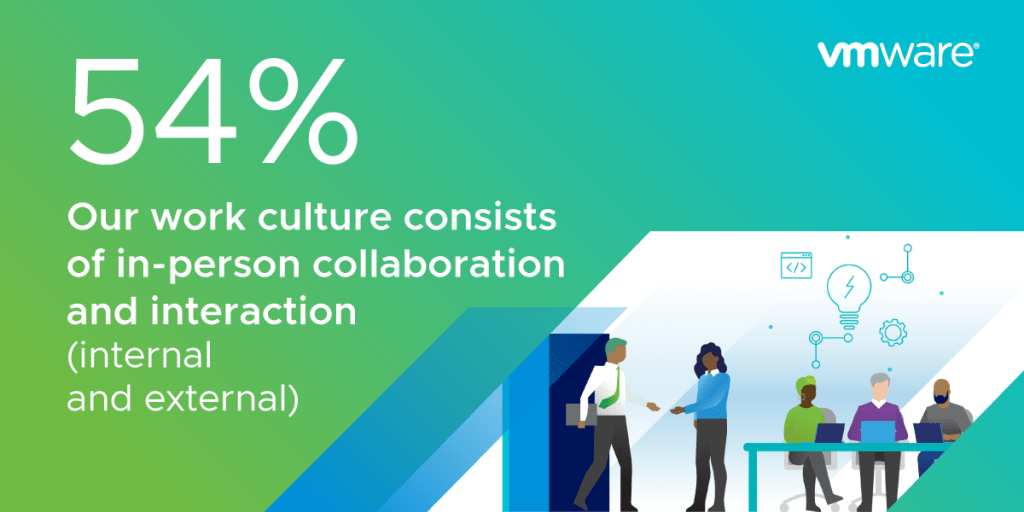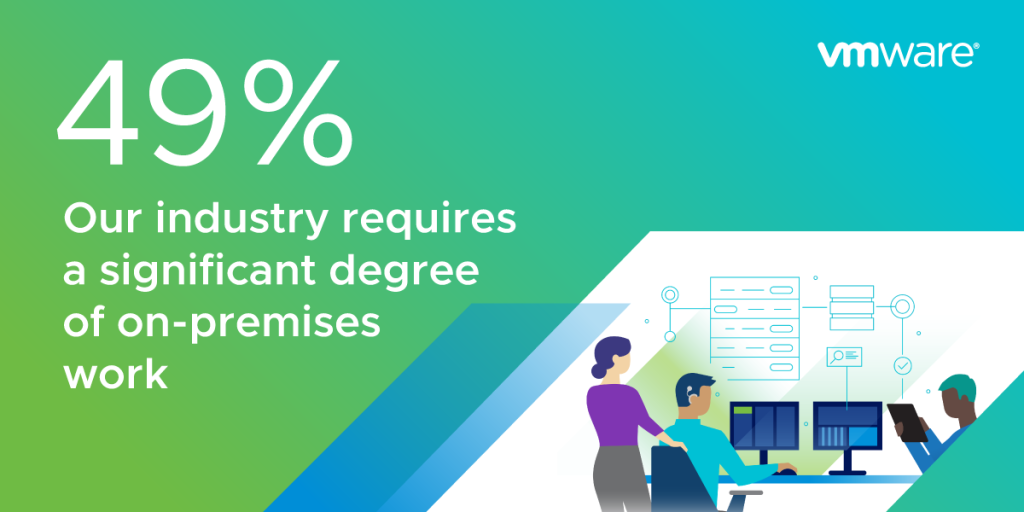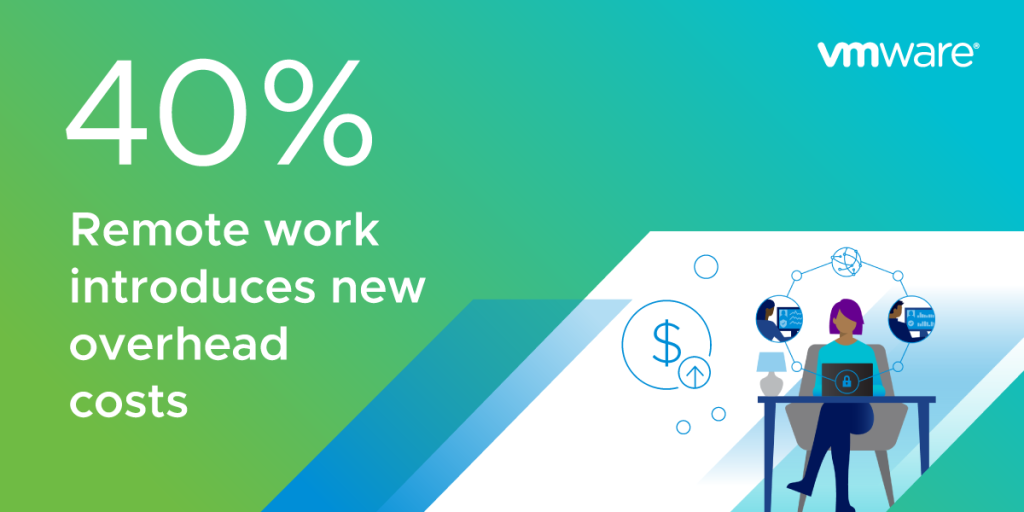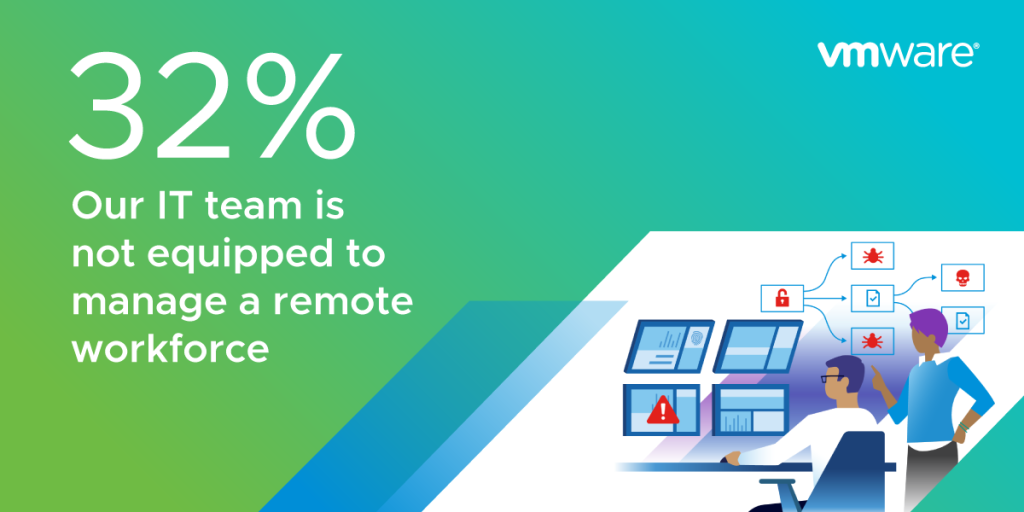Management, take note:
Employee expectations have changed since the onset of the pandemic.
It’s 2021 and businesses are navigating a new normal. In hindsight, 2020 truly was a wake-up call to organizations relying on legacy technology to engage customers and employees.
Distributed Work Is Here to Stay
In response to suddenly fully remote workforces:

For most, it was a mad scramble to simply connect. For others, it was anxiety around security and scaling. For all, there’s still urgency in future-proofing their organizations to maintain resiliency and trust.
That’s because distributed workforce environments are still facing challenges, including:
- Increased security risks.
- A subpar digital employee experience.
- The complexity created by siloed, disparate toolsets and inefficient technology.
And leaders are looking for an “anywhere workforce” solution to not only ease pandemic burdens, but also benefit employees and the organization.

Distributed Work Catalyzes a Culture Revolution in 2020
In 2020, workforces across industries proved that business doesn’t stop when employees work from home—or really, from anywhere. And thanks to technology, many employees feel a greater sense of connectedness and empowerment. Now, they’re free to do their best work how they want and where they want.
Yet in this new remote work world, organizational leaders are at a crossroads. And employees wonder whether their businesses will adapt. Will organizations truly embrace distributed work and enable a future ready workforce?
Distributed Work Challenges
A new survey reveals that the top distributed work challenges were, by large, disproven when workers were forced to go remote in early 2020.
Managers never expected that a majority of their workplaces could be both remote and successful. But I believe change is still to come. I expect there to be not only a rethink of powers but also of employee ownership.
MARIBEL LOPEZ, TECHNOLOGY INDUSTRY ANALYST AND STRATEGIC ADVISOR AT LOPEZ RESEARCH
Distributed Work Advantages
Today, more employees believe the ability to work remotely is not merely a perk, but a prerequisite—up from 30% to 42% globally since the pandemic. And although a majority of survey respondents have experienced personal benefits—from improved connections to increased empowerment—in the near term, they understand long-term success requires a strategic approach for their particular organization.
But something is missing. And it’s a much-needed update to management practices and boardroom cultures. Line-of-sight management styles need to change to reflect that work doesn’t happen only in the office. This means managers no longer worrying their teams will stray off task (42%) and relieving the pressure employees feel to be online longer (60%).
“Key strategies are needed to transform the turmoil of this challenging time and to truly create opportunities for everyone—but also for those who need it most,” said Gelsinger in a recent podcast conversation with Lopez.
The two agree the most important strategies for managers right now are fusing empathy and urgency, as well as democratizing digital access.
As that process goes further, organizations will build more diverse workforces. They’ll also improve the ability to attract talent that might not have been available to the organization before. Culture and collaboration are two potential risks.
Both Gelsinger and Lopez believe leaders must be vigilant about addressing those concerns.
What organizations really need is cultural ambassadors who are empathetic. And these managers must have the appropriate soft skills and expertise to inspire employees, making them feel part of the bigger organization. The opportunity before us is to rethink management dynamics.
MARIBEL LOPEZ, TECHNOLOGY INDUSTRY ANALYST AND STRATEGIC ADVISOR, LOPEZ RESEARCH
Unlocking Opportunities for Success
2020 has changed everything about the human experience in such a short time. But the pivot presents opportunities for today’s and tomorrow’s leaders to overcome obstacles on the way to bigger success.
Among the biggest gaps right now is there are “tens of millions of co-located managers that are now remote managers. They were never instructed or taught how to lead a remote team, where every individual is in a different home with a different connection with a different workspace,” explained Darren Murph, head of remote at GitLab, a leader in DevOps lifecycle software. “This is a lot. It’s a lot for people. It’s a lot for leaders.”
So, what can these leaders do to better support their employees? Experts describe the key skills employees need in their remote work leaders:
- Trust builder: “Managers fear a lack of transparency,” said Laurel Farrer, a leading remote work strategist and the chief executive officer of Distribute Consulting. Yet, they should be “encouraging employees working from different locations to take control over their results.”
- Effective communicator: Strong, visible messaging is key to success. “Communication at the right cadence helps remote workers feel more supported in their work,” said Susan Insley, vice president of human resources at VMware.
- Empathetic guide: Getting up to speed quickly on remote work leadership, “requires a lot more empathy. It requires an appreciation for textual communication and a bias for asynchronous collaboration. It requires a progressive stance on workplace functions,” said Murph.
In summary, a manager’s role needs to be about ensuring employees have what they need to deliver best results, reinforcing positive work habits and helping employees track results and while preventing isolation.
Panel Debate: Making the Anywhere Workforce a Reality
The Great Equalizer
For leaders willing to make changes, remote work creates greater opportunities for employees—from boosting diversity to making new ideas heard.
Survey respondents said they feel a greater share of voice, including:
- Working parents.
- People with disabilities.
- Those living outside of economic hubs.
Although diversity is a huge gain, “managers also have to keep inclusivity top of mind as we choose communication and collaboration approaches—and even performance metrics going forward into our new normal of working,” advised Shanis Windland, vice president of human resources at VMware.
“When technology is working well, it connects us. And everyone is equally represented. In the case of video, on the screen, individuals can hear better, participate easily and feel more included,” she said.
She advances top tips that management consultancies, such as McKinsey & Company, do to bring more inclusivity into distributed workforces:
- Openness: Making sure employees feel safe enough to express different thoughts, ideas and concerns.
- Equality: Creating fairness, an equal chance for all employees to succeed no matter where they are located.
- Belonging: Sharing positive connections with one another and the organization.
Working from home raises new questions around inclusivity, communication and employee engagement. It’s important that companies remedy traditional and new power dynamics in a distributed workforce.
HANIS WINDLAND, VICE PRESIDENT OF HUMAN RESOURCES, VMWARE
Industry Spotlight: Healthcare & Education
While every industry felt urgency to get remote work right, the stakes were highest for two industries in particular: healthcare and education. Their mission-driven responsibilities for patient lives and student futures were on the line.
For leaders advancing distance learning and telehealth initiatives, survey respondents also believe there are greater opportunities for personal, professional and institutional benefits.


Leveling the Playing Field for Innovation & Growth
It turns out that the art of celebrating people from a wide variety of backgrounds, experiences and perspectives isn’t just a nice thing to do, it’s smart business.
SHANIS WINDLAND, VICE PRESIDENT OF HUMAN RESOURCES, VMWARE
Clearly, the flexibility that remote work provides is good for employees. But is it just as good for business? According to Windland and survey respondents, the answer is yes.
“Global studies have repeatedly proven that diversity and inclusion (D&I)-advanced companies are more productive, innovative and successful. They are more likely to generate better-than-average profits, capture new markets and generate more revenue from innovation,” she said.
Enabled by digital technologies, survey respondents said:
- Productivity increased or stayed the same (67%)
- Morale increased or stayed the same (64%)
- Made top-tier talent recruitment easier (66%)
Smaller organizations and satellite offices are the biggest winners***:

I think there’s only two things that could double the world’s GDP in my lifetime. One is artificial intelligence. The other is the mass proliferation of remote work. By just giving people an internet connection, you allow people to inject innovation and ideas into companies. That is immensely powerful.
DARREN MURPH, HEAD OF REMOTE, GITLAB
“Because office space is a long-term investment, the shift in dollars is likely to be a longtail proposition,” said Lopez. “So while that planning is underway, there’s great upside that management teams can be considering and that’s around employee training.”
For example, “an enterprise could engage higher-cost cybersecurity experts that they couldn’t afford before—not necessarily as permanent employees but consultants—to better train and upskill their own employees,” Lopez continued.
The Future Ready Workforce
Rapid response was critical to continued business at the start of the pandemic. But establishing a successful distributed workforce strategy for business resiliency requires rethinking where and how teams work.
“Future Ready Workforce” principles from VMware offer practical steps. Key tenets include:
- Modernizing IT deployments to take advantage of cloud and modern device and infrastructure management
- Empowering distributed workforces with critical apps and data through best-in-class digital workspaces and virtual desktop infrastructure
- Focusing on employee experience to maintain an “anywhere organization,” while attracting and retaining the best talent
So, leaders, the next move is yours.
- Will you go back to work as usual or move forward—and ahead—with digital solutions that allow you to confidently respond to challenges?
- Will you adapt to your new reality and build for tomorrow?
- Will you embrace a strategy that returns your organization to growth, differentiation and innovation?
Your employees want the freedom and flexibility to work as they are. It’s up to you to deliver.






